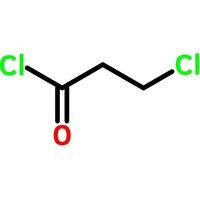3 Chloropropionyl Chloride
Product Details:
- Molecular Formula C3H4Cl2O
- Storage Room Temperature
- Molecular Weight 126.97 Grams (g)
- Boiling point 143-145 DegreeC
- Place of Origin India
- HS Code 29159090
- Assay Upto 99%
- Click to View more
3 Chloropropionyl Chloride Price And Quantity
- 550 INR/Kilograms
- 100 Kilograms
3 Chloropropionyl Chloride Product Specifications
- 29159090
- Upto 99%
- C3H4Cl2O
- anticonvulsant
- 3-Chloropropionic Acid Chloride
- Other
- Room Temperature
- Colorless
- Medicine Grade
- 126.97 Grams (g)
- Liquid
- 143-145 DegreeC
- India
- 625-36-5
- Clear liquid
- Upto 99%
3 Chloropropionyl Chloride Trade Information
- 1500 Kilograms Per Day
- 7 Days
- Yes
- Free samples are available
- 250Kg/Drum
- All India
Product Description
Komal Industries is Manufacturing of 3-Chloropropionyl Chloride (3 CPC) which is a widely used Pharmaceuticals intermediate. it is used in making anticonvulsant drug.
Introduction
3Chloropropionyl chloride also known as betachloropropionyl chloride is a chemical compound with a critical role in organic synthesis This compound is characterized by its structure properties uses and safety considerations In this extensive description we will delve into the various aspects of 3chloropropionyl chloride providing a comprehensive understanding of its importance in the field of chemistry
Chemical Properties
Molecular Formula C3H4Cl2O
Molecular Weight 12997 gmol
IUPAC Name 3Chloropropanoyl chloride
Structure
3Chloropropionyl chloride consists of a propionyl group a threecarbon chain with a carbonyl group at one end and a chlorine atom attached to the third carbon This structure is crucial to its reactivity and its role as an intermediate in various chemical reactions
Physical Properties
Melting Point The melting point of 3Chloropropionyl chloride can vary but typically falls within the range of 10C to 5C
Boiling Point The boiling point is typically around 80C at standard atmospheric pressure
Solubility It is generally soluble in many organic solvents but not very soluble in water This solubility profile influences its use in different applications
Synthesis
The synthesis of 3Chloropropionyl chloride involves a chlorination reaction typically using a chlorinating agent One common method for its synthesis is as follows
Chlorination
3Chloropropionyl chloride is often prepared by the reaction of 3chloropropionic acid with a chlorinating agent such as thionyl chloride SOCl2 or phosphorus pentachloride PCl5
The reaction can be represented as
C3H5ClO2 SOCl2 C3H4Cl2O2 HCl SO2
After synthesis purification steps such as distillation or recrystallization are often employed to obtain a pure product
Applications
3Chloropropionyl chloride finds application in various industries and research fields due to its role as a versatile intermediate in organic synthesis Here are some key applications
Pharmaceuticals
3Chloropropionyl chloride serves as a crucial intermediate in the synthesis of pharmaceuticals including antiinflammatory drugs and agrochemicals
It is used in the production of pharmaceutical compounds that have diverse therapeutic applications
Agrochemicals
In the agricultural sector it is employed in the creation of pesticides and herbicides to control pests and effectively
Its role in agrochemical synthesis contributes to improved crop yields and pest management
Chemical Intermediates
It is used as an essential building block for the synthesis of various chemical intermediates enabling the creation of a wide range of chemical compounds
These intermediates serve as starting materials for the production of plastics polymers and specialty chemicals
Research and Development
In research laboratories 3Chloropropionyl chloride plays a significant role in the development of new chemical compounds and materials
Chemists use it as a versatile tool to modify and synthesize specific organic molecules for experimental purposes
Polymer Chemistry
In polymer chemistry it can be employed for modifying polymers and plastics enhancing their properties for specific applications
Safety Considerations
Proper handling and safety measures are paramount when working with 3Chloropropionyl chloride due to its potential hazards
Toxicity This compound is toxic if inhaled absorbed through the skin or ingested Consequently it should only be handled by trained personnel following strict safety protocols
Corrosive Nature It is corrosive and may cause burns upon contact with the skin eyes or mucous membranes Appropriate protective equipment such as gloves goggles and lab coats should be worn when handling it
Storage It should be stored in a cool dry place away from incompatible materials and sources of heat or ignition Adequate ventilation is necessary in storage areas to prevent the buildup of harmful fumes
First Aid In case of accidental contact with eyes skin or ingestion immediate medical attention should be sought and firstaid procedures should be administered according to established safety protocols
Conclusion
In conclusion 3Chloropropionyl chloride is a significant chemical compound with a wide range of applications in the pharmaceutical agrochemical and chemical industries Its synthesis chemical properties and safety considerations are crucial factors for researchers chemists and industries that utilize it in various processes As with any chemical compound adhering to strict safety guidelines and best practices is essential to ensure safe handling and usage in industrial and research settings Understanding the versatility and importance of 3Chloropropionyl chloride in organic synthesis underscores its role in advancing science and industry





 Send Inquiry
Send Inquiry Send SMS
Send SMS Call Me Free
Call Me Free